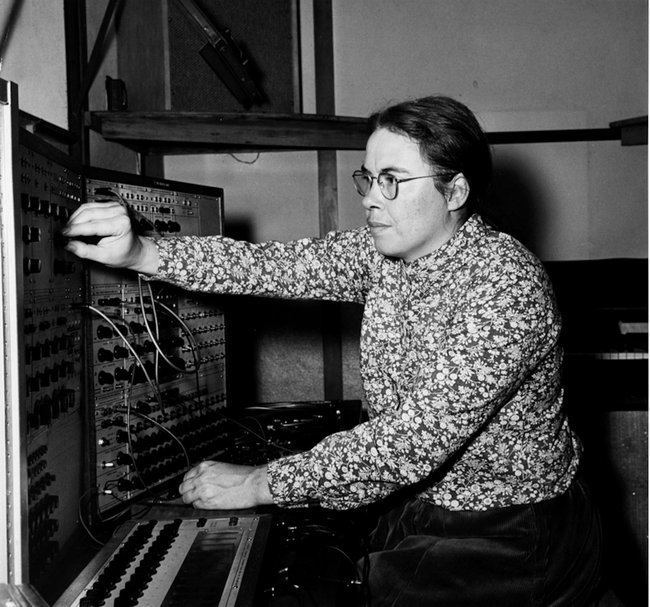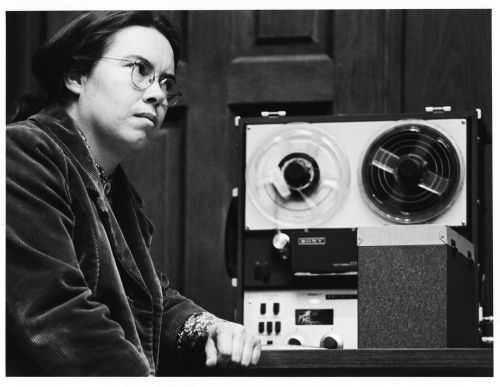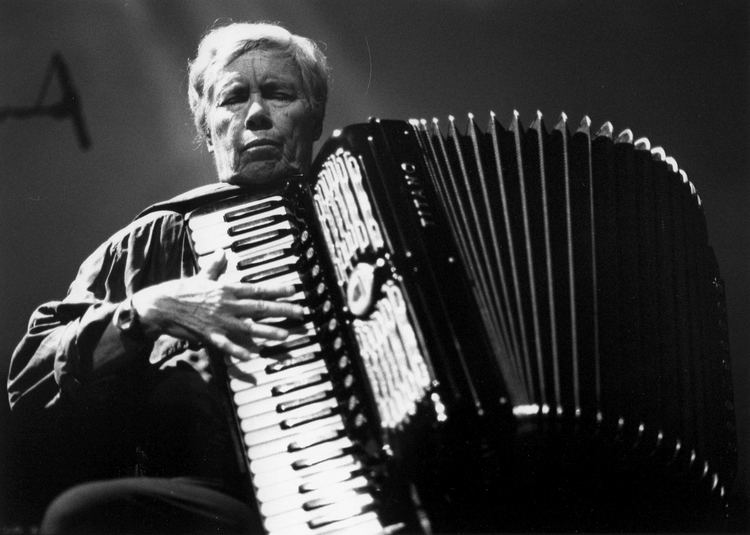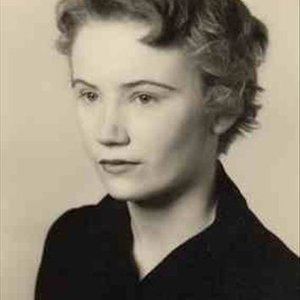Name Pauline Oliveros | Role Composer | |
 | ||
Albums Deep Listening, Accordion & Voice, Alien Bog / Beautiful Soop, Electronic Works, Crone Music Profiles | ||
Kqed spark pauline oliveros
Pauline Oliveros (May 30, 1932 – November 24, 2016) was an American composer, accordionist and a central figure in the development of experimental and post-war electronic art music.
Contents
- Kqed spark pauline oliveros
- Pauline oliveros bye bye butterfly
- Early life and career
- UCSD
- Deep Listening
- Sonic awareness
- Composer teacher author
- Notable works
- Books
- Films
- Listening
- References

She was a founding member of the San Francisco Tape Music Center in the 1960s, and served as its director. She taught music at Mills College, the University of California San Diego (UCSD), Oberlin Conservatory of Music, and Rensselaer Polytechnic Institute. Oliveros authored books, formulated new music theories, and investigated new ways to focus attention on music including her concepts of "Deep Listening" and "sonic awareness". She was an Eyebeam resident.

Pauline oliveros bye bye butterfly
Early life and career

Oliveros started to play music as early as kindergarten, and at nine years of age she began to play the accordion, received from her mother because of its popularity in the 1940s. She later went on to learn the tuba and French horn for grade school and college music. At the age of sixteen she had decided to be a composer.
Oliveros arrived in California and supported herself with a day job, and supplemented this by giving accordion lessons to students. From there Oliveros went on to attend Moores School of Music at the University of Houston studying with Willard A. Palmer and earned BFA degree in compositions from San Francisco State College where her teachers included composer Robert Erickson, with whom she had private lessons and who mentored her for six to seven years. This is also where she met artists Terry Riley, Stuart Dempster and Loren Rush.
When Oliveros turned 21, she obtained her first tape recording deck, which led to her creating her own pieces and future projects in this field. Oliveros was one of the original members of the San Francisco Tape Music Center, which was an important resource for electronic music on the U.S. West Coast during the 1960s. The Center later moved to Mills College, where she was its first director - it is now called the Center for Contemporary Music. Oliveros often improvised with the Expanded Instrument System, an electronic signal processing system she designed, in her performances and recordings.
UCSD
In 1967, Oliveros left Mills to take a faculty music department position at the University of California San Diego. There, Oliveros met theoretical physicist and karate master Lester Ingber, with whom she collaborated in defining the attentional process as applied to music listening. She also studied karate under Ingber, achieving black belt level. In 1973, Oliveros conducted studies at the University's one-year-old Center for Music Experiment; she served as the Center's director from 1976 to 1979. In 1981, to escape creative constriction, she left her tenured position as full Professor of Music at University of California San Diego and relocated to upstate New York to become an independent composer, performer, and consultant.
Deep Listening
In 1988, as a result of descending 14 feet into an underground cistern to make a recording, Oliveros coined the term "Deep Listening", a pun that has blossomed into "an aesthetic based upon principles of improvisation, electronic music, ritual, teaching and meditation. This aesthetic is designed to inspire both trained and untrained performers to practice the art of listening and responding to environmental conditions in solo and ensemble situations". Dempster, Oliveros and Panaiotis then became Deep Listening Band, and Deep Listening became a program of Pauline Oliveros Foundation, founded in 1985. The Deep Listening program includes annual listening retreats in Europe, New Mexico and in upstate New York, as well as apprenticeship and certification programs. Pauline Oliveros Foundation changed its name to Deep Listening Institute, Ltd. in 2005. The Deep Listening Band, which included Oliveros, David Gamper (1947–2011) and Stuart Dempster, specializes in performing and recording in resonant or reverberant spaces such as caves, cathedrals and huge underground cisterns. They have collaborated with Ellen Fullman and her long-string instrument, as well as countless other musicians, dancers and performers. The Center for Deep Listening at Rensselaer, under the direction of Tome Hahn, is now established and is the steward of the former Deep Listening Institute, Ltd. A celebratory concert was held on March 11, 2015 at the Experimental Performing Arts Center (EMPAC) at the Rensselaer Polytechnic Institute in Troy, New York.
Sonic awareness
Von Gunden names a new musical theory developed by Oliveros, "sonic awareness", and describes it as "the ability to consciously focus attention upon environmental and musical sound", requiring "continual alertness and an inclination to be always listening" and which she describes as comparable to John Berger's concept of visual consciousness (as in his Ways of Seeing). Oliveros discusses this theory in the "Introductions" to her Sonic Meditations and in articles. Von Gunden describes sonic awareness as "a synthesis of the psychology of consciousness, the physiology of the martial arts, and the sociology of the feminist movement", and describes two ways of processing information, "attention and awareness", or focal attention and global attention, which may be represented by a dot and circle, respectively, a symbol Oliveros commonly employs in compositions such as Rose Moon (1977) and El Rilicario de los Animales (1979). Later this representation was expanded, with the symbol quartered and the quarters representing "actively making sound", "actually imagining sound", "listening to present sound" and "remembering past sound", with this model used in Sonic Meditations. Practice of the theory creates "complex sound masses possessing a strong tonal center".
Composer, teacher, author
Oliveros received a 1994 Foundation for Contemporary Arts Grants to Artists award.
Oliveros taught at Rensselaer Polytechnic Institute and Mills College. She was openly lesbian. In 1975 Oliveros met her eventual partner, performance artist Linda Montano. The titles of Oliveros' pieces Rose Moon and Rose Mountain refer, Montano having gone by Rose Mountain at one time.
Oliveros was the author of five books, Sounding the Margins: Collected Writings 1992–2009, Initiation Dream, Software for People, The Roots of the Moment, and Deep Listening: A Composer's Sound Practice.
She contributed a chapter to Sound Unbound: Sampling Digital Music and Culture (The MIT Press, 2008) edited by Paul D. Miller a.k.a. DJ Spooky.
In 2007, Oliveros received the Resounding Vision Award from Nameless Sound. She was the 2009 recipient of the William Schuman Award, from Columbia University School of the Arts.
In 2012, Oliveros received the John Cage Award from the Foundation for Contemporary Arts.
She was a patron of Soundart Radio in Dartington, Devon, UK.
Oliveros' work Deep Listening Room was featured in the 2014 Whitney Biennial.
Some of her music was featured in the French video game NaissanceE.
Oliveros was a member of Avatar Orchestra Metaverse, a global collaboration of composers, artists and musicians that approaches the virtual reality platform Second Life as an instrument itself.
